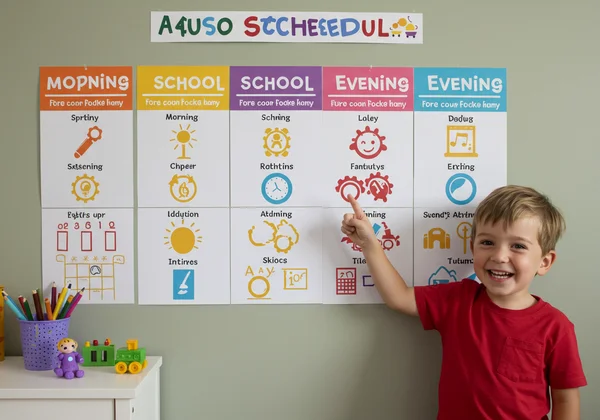Vanderbilt Assessment Results: 7 Strategies for ADHD Home & School Support
Navigating your child's Vanderbilt assessment results can bring a mix of emotions—relief, concern, and perhaps a little uncertainty. You've taken a crucial step towards understanding their unique needs, and now you might be wondering, what does a high score on the Vanderbilt assessment mean for my family? This guide offers seven actionable, non-medical strategies to support your child both at home and school, transforming this moment into a positive journey of empowerment. If you're just starting this process, you can begin the assessment for initial insights.
Understanding Your Vanderbilt Results: What Comes Next?
Before diving into strategies, it's crucial to frame the results correctly. The Vanderbilt Assessment Scale is a highly respected ADHD screening tool, not a final diagnosis. Think of it as a detailed map that highlights areas where your child might need extra support. It provides a structured way to observe and report behaviors related to inattention, hyperactivity, and other associated conditions.
Deciphering Your Child's Vanderbilt Assessment Scores
Your report is likely broken down into several sections. Scores above a certain threshold in the initial sections suggest that symptoms of ADHD are present and may be impacting your child's daily life. The scale also screens for common co-occurring conditions like Oppositional-Defiant Disorder (ODD), Conduct Disorder (CD), anxiety, and depression. Seeing elevated scores here simply means these are areas to discuss further with a professional. The key is not to get lost in the numbers but to see them as indicators pointing you toward the right conversations and resources.
The Importance of Professional Consultation
This is the most critical next step. Your report from our online Vanderbilt assessment is the perfect document to bring to a qualified healthcare professional. Schedule an appointment with your child's pediatrician, a child psychologist, or a developmental-behavioral pediatrician. They are the only ones who can conduct a comprehensive evaluation, consider all factors, and provide an official diagnosis. This professional guidance is essential for creating a tailored support plan that is right for your child.

Effective ADHD Parenting Strategies for Home Life
Creating a supportive home environment can make a world of difference. These strategies focus on consistency, structure, and positive connection, which are beneficial for all children but are especially crucial for those with ADHD-like symptoms.
1. Structuring Routines & Creating Predictability
Children with attention challenges thrive on predictability. When they know what to expect, their anxiety decreases, and they can better manage their focus and energy.
-
Visual Schedules: Create a chart with pictures or simple words for morning, after-school, and bedtime routines. This externalizes the plan, so your child doesn't have to hold it all in their working memory.
-
Consistent Timings: Try to stick to regular times for waking up, meals, homework, and bedtime, even on weekends. This helps regulate their internal clock.
-
A "Launch Pad": Designate a specific spot by the door for everything needed for the next day—backpack, shoes, jacket, sports gear. This minimizes morning chaos and frantic searching.

2. Positive Reinforcement & Behavior Management Tips
Often, children with ADHD receive a lot of negative feedback. Shifting your focus to positive reinforcement can build their self-esteem and motivate them.
- Catch Them Being Good: Make a point to praise specific positive behaviors. Instead of "good job," say, "I love how you started your homework right after your snack without being asked!"
- Reward Systems: For challenging tasks like homework or chores, consider a simple reward system. A sticker chart where they earn privileges (like extra screen time or a special outing) can be very effective. The key is to keep it immediate and attainable.
3. Fostering Clear Communication and Connection
Your instructions can sometimes get lost in translation. Use clear, direct communication techniques to help your child process requests.
- One-Step Directions: Give one instruction at a time instead of a multi-step command. Say, "Please put on your shoes," wait for it to be done, then say, "Now, please get your backpack."
- Make Eye Contact: Before giving a direction, gently get their attention by saying their name and making eye contact. This ensures you have their focus before you speak.
- Dedicated Time: Spend at least 10-15 minutes of one-on-one time with your child each day doing something they enjoy. This builds a strong, positive connection that makes discipline and guidance much more effective.
Supporting Your Child with ADHD at School
Success at school often requires a strong partnership between home and the classroom. Your Vanderbilt results are a powerful tool for opening this dialogue.
4. Partnering with Teachers & School Staff
Your child's teacher is your most important ally. Schedule a meeting to discuss the results from both the parent rating scale and the teacher version, if available.
-
Share, Don't Tell: Approach the conversation as a collaboration. Ask the teacher what they are observing in the classroom. Share what you are seeing at home and the insights from the assessment.
-
Establish a Communication System: Set up a regular check-in, whether it's a weekly email or a communication notebook. This helps you both stay on the same page and address small issues before they become big problems.

5. Exploring Classroom Accommodations & Learning Strategies
Even without a formal diagnosis, many teachers are willing to implement simple accommodations to help a student succeed.
- Preferential Seating: Sitting near the teacher and away from distractions like windows or doors can significantly improve focus.
- Movement Breaks: Allowing the child to take short breaks to walk around, stretch, or run an errand (like taking a note to the office) can help manage hyperactivity.
- Chunking Assignments: Breaking large assignments into smaller, more manageable parts with separate deadlines can prevent overwhelm. These are excellent points to discuss when you explore a formal 504 Plan or IEP with the school.
Beyond the Report: Utilizing Your AI-Powered Insights
While a standard report gives you the scores, our unique platform offers something more—a way to translate those scores into a truly personalized action plan.
6. How Personalized Analysis Guides Your Action Plan
If you opted for the AI-Personalized Report, you have access to deeper insights. This feature analyzes your specific answers and background information to provide context that a standard score cannot. It connects your child’s behaviors to real-world scenarios, offering tailored suggestions that fit your family’s unique situation. It helps answer not just "what" the scores are, but "why" they might be happening and "how" you can specifically help.

7. Focusing on Strengths and Challenges
The AI-powered analysis also highlights your child's potential strengths alongside their challenges. A child who is "distractible" might also be incredibly creative and curious. A child who is "hyperactive" may have boundless energy and passion. This balanced perspective is crucial. It allows you to nurture their gifts while supporting their difficulties, building their confidence and ensuring they see themselves as more than just a set of symptoms. Use these insights to create a plan that plays to their strengths.
Empowering Your Child: Next Steps After Your Vanderbilt Assessment
Receiving your child's Vanderbilt assessment results is a pivotal moment. It’s the start of a new chapter in understanding and supporting them. By implementing structured routines at home, partnering with their school, and leveraging deep, personalized insights, you can create a positive path forward. Remember, this journey is a marathon, not a sprint. Be patient with your child and with yourself.
Your next step is to share these results with a healthcare professional. Use the knowledge you’ve gained as a foundation for that critical conversation. Continue to explore resources and remember that you are your child's greatest advocate.
Frequently Asked Questions About Vanderbilt Results
What does a high score on the Vanderbilt assessment mean?
A high score on the Vanderbilt assessment indicates that a child is showing a significant number of symptoms related to ADHD and/or other behavioral or emotional conditions. It serves as a strong indicator that a formal evaluation by a healthcare professional is recommended. It is a screening result, not a diagnosis, but it provides a reliable, evidence-based starting point for discussion.
Is the Vanderbilt ADHD assessment accurate?
Yes, the NICHQ Vanderbilt Assessment Scale is considered a highly reliable and valid screening tool for ADHD in children aged 6-12. It is widely used by pediatricians and psychologists and is recommended by the American Academy of Pediatrics. Its accuracy is highest when information is gathered from both parents and teachers, which our ADHD screening tool facilitates.
What conditions does the Vanderbilt Assessment screen for?
The primary focus of the Vanderbilt assessment scale is to screen for the three presentations of ADHD: predominantly inattentive, predominantly hyperactive-impulsive, and combined. Additionally, it includes screening questions for common co-occurring conditions, including Oppositional-Defiant Disorder (ODD), Conduct Disorder (CD), anxiety, and depression, providing a comprehensive overview of a child's behavioral health. You can get your report today to begin understanding your child's needs.